Decision Support System in the Field of Defects Assessment in the Metal Matrix Composites Castings
Abstract
1. Introduction
- -
- Precisely identify them;
- -
- Determine why they form;
- -
- Determine which manufacturing stage causes their formation;
- -
- Promptly take countermeasures.
2. Classification of Metal Matrix Composites
2.1. Division of Composite Materials
- -
- Liquid matrix technologies (only these will be the subject of this paper because it concerns defects of castings);
- -
- Deformation technologies, i.e., those that use plastic processing methods;
- -
- Sinter technologies.
2.2. Direct Methods in Which the So-Called “In Situ” Composites Are Made
2.3. Indirect Methods, Called Ex-Situ Methods
3. Classification of Defects in Castings of Various Metal Materials
- -
- Transfer of information in research work, during the educational process, or in the manufacturing process;
- -
- Elimination of defective castings from further stages of the manufacturing process;
- -
- Intervention activities aimed at removing the causes of defect formation from the manufacturing process.
- -
- Satisfactory castings with acceptable defects;
- -
- Castings with repairable defects;
- -
- Castings with disqualifying defects.
- -
- Enable unequivocal identification of defects;
- -
- Provide methods to detect them;
- -
- Provide causes of their formation;
- -
- Suggest technological means to prevent their formation.
- -
- Outer metal gain;
- -
- Inner and outer cavities;
- -
- Breaks in casting continuity;
- -
- Surface defects;
- -
- Incompleteness of the product;
- -
- The inaccuracy of dimensions or shape;
- -
- Structural inclusions or anomalies.
- Metallic growth;
- Cavities;
- Breaks in continuity;
- Surface defects;
- Incomplete casting;
- Incorrect dimensions or shapes;
- Inclusions or abnormal structure.
4. Classification of Defects in Metal Composite Castings and a Proposal for the Division of Defects in Castings Made from Traditional Materials (Cast Steel, Cast Iron, Non-Ferrous Alloys) and Composite Materials
5. Open Atlas of Casting Defects Project
- -
- View the atlas of defects containing casting defects and their detailed description (view mode, code C001);
- -
- View casting defects’ classifications (view mode, code C001);
- -
- Search for casting defects using many different criteria (view mode, code C001);
- -
- Edit the knowledge base—modify and complement information on casting defects (edit mode, code B001);
- -
- Obtain expert advice (analysis mode, code A001);
- -
- Use the forum to exchange experience and knowledge (analysis mode, code A001);
- -
- Open atlas of casting defects management (admin mode, code X001).
- -
- Qualification of the defect;
- -
- Name/names of the defect—this field contains valid/acceptable/common names of the given defect;
- -
- Defect code—the code assigned to the classification of a defect of castings made from traditional materials (cast steel, iron, non-ferrous alloys) and composite materials on which the Open Atlas of Casting Defects is based;
- -
- Occurrence in a given material group—is the defect present in castings made from traditional or composite materials;
- -
- Description of the defect that occurred;
- -
- Causes of the defect;
- -
- Defect detection method.
6. Conclusions
- -
- Complement the classification of defects in castings of traditional materials, with the group of defects characteristic for castings being a concern of this paper;
- -
- Unequivocally define defects characteristic for castings of studied composites;
- -
- Supplement the proposed classification with possible defects not taken into consideration thanks to its open character;
Author Contributions
Funding
Conflicts of Interest
References
- Gawdzińska, K.; Chybowski, L.; Przetakiewicz, W. Proper matrix-reinforcement bonding in cast metal matrix composites as a factor of their good quality. Arch. Civ. Mech. Eng. 2015, 16, 553–563. [Google Scholar] [CrossRef]
- Konopka, Z. Metalowe Kompozyty Odlewane; Wydawnictwo Politechniki Częstochowskiej: Częstochowa, Poland, 2011. [Google Scholar]
- Sobczak, J. Metal Matrix Composites; Institute of Foundry and Institute of Motor Transport: Cracow/Warsaw, Poland, 2001. [Google Scholar]
- Hari Babu, N.; Tzamtzis, S.; Barekar, N.; Patel, J.B.; Fan, Z. Fabrication of Metal Matrix Composites under Intensive Shearing. Solid State Phenom. 2008, 141–143, 373–378. [Google Scholar]
- Qi, L.; Liu, J.; Guan, J.; Su, L.; Zhou, J. Damage prediction for magnesium matrix composites formed by liquid-solid extrusion process based on finite element simulation. Trans. Nonferrous Met. Soc. China 2010, 20, 1737–1742. [Google Scholar] [CrossRef]
- Zhao, C.; Zhou, Y.; Xing, X.; Liu, S.; Ren, X.; Yang, Q. Precipitation stability and micro-property of (Nb, Ti)C carbides in MMC coating. J. Alloys Compd. 2018, 763, 670–678. [Google Scholar] [CrossRef]
- Olszówka-Myalska, A.; Chrapoński, J. Study of interaction between liquid magnesium alloy and glassy carbon particles. Solid State Phenom. 2015, 227, 178–181. [Google Scholar] [CrossRef]
- Konopka, K.; Olszówka-Myalska, A. Composites ceramic-metal with int. Mater. Chem. Phys. 2003, 81, 329–332. [Google Scholar] [CrossRef]
- Kong, X.; Yang, L.; Zhang, H.; Chi, G.; Wang, Y. Optimization of surface roughness in laser-assisted machining of metal matrix composites using Taguchi method. Int. J. Adv. Manuf. Technol. 2017, 89, 529–542. [Google Scholar] [CrossRef]
- Bakkar, A.; Ahmed, M.M.Z.; Alsaleh, N.A.; Seleman, M.M.E.-S.; Ataya, S. Microstructure, wear, and corrosion characterization of high TiC content Inconel 625 matrix composites. J. Mater. Res. Technol. 2019, 8, 1102–1110. [Google Scholar] [CrossRef]
- Olszówka-Myalska, A.; Myalski, J. Applying stir casting method for Mg alloy-short carbon fiber composite processing. Compos. Theory Pract. 2019, 14, 81–85. [Google Scholar]
- Olszówka-Myalska, A. Spiekane kompozyty magnezowe typu in sit. Mechanik 2016, 5, 504–505. [Google Scholar] [CrossRef]
- Falęcki, Z. Analysis of Casting Defects; AGH: Crakow, Poland, 1997. [Google Scholar]
- Orłowicz, W.; Tupaj, M.; Mróz, M.; Guzik, E. Evaluation of ductile iron casting material quality using ultrasonic testing. J. Mater. Process. Technol. 2010, 210, 1493–1500. [Google Scholar] [CrossRef]
- Ghosh, A.; Mallik, A.K. Manufacturing Science; Ellis Horwood: New York, NY, USA, 1986. [Google Scholar]
- David, N. Casting Defects Handbook; American Foundry Society: Schaumburg, IL, USA, 2005. [Google Scholar]
- DeGarmo, E.P.; Black, J.T.; Kohser, R.A. Materials and Processes in Manufacturing, 8th ed.; John Wiley & Sons: Hoboken, NJ, USA, 1999. [Google Scholar]
- Campbell, J. Castings, 2nd ed.; Elsevier: Amsterdam, The Netherlands, 2003. [Google Scholar]
- Jadhav, B.R.; Jadhav, S.J. Investigation and analysis of cold shut casting defect and defect reduction by using 7 quality control tools. Int. J. Adv. Eng. Res. Stud. 2013, II, 28–30. [Google Scholar]
- Monroe, R. Porosity in Castings; Paper 05-245(04).pdf; American Foundry Society: Schaumburg, IL, USA, 2005. [Google Scholar]
- Naro, R.L. Porosity Defects in Iron Castings from Mould-Metal Interface Reactions. In AFS Transactions; Paper 99-206; American Foundry Society: Schaumburg, IL, USA, 1999; pp. 839–851. Available online: https://www.asi-alloys.com/pdf/Naro.pdf (accessed on 11 August 2020).
- Kuyucak, S. Sponsored Research: Clean Steel Casting Production—Evaluation of Laboratory Castings. In AFS Transactions; Paper 07-102(09); American Foundry Society: Schaumburg, IL, USA, 2007; pp. 1–14. [Google Scholar]
- Major-Gabryś, K. Environmentally Friendly Foundry Moulding and Core Sands; Archives of Foundry Engineering: Katowice-Gliwice, Poland, 2016. (In Polish) [Google Scholar]
- Perzyk, M.; Waszkiewicz, S.; Kaczorowski, M.; Jopkiewicz, A. Odlewnictwo; Wydawnictwo Naukowo-Techniczne: Warsaw, Poland, 2009. [Google Scholar]
- Essam, B.M.; Samah, M.; Sayed, A.-W.; Tamer, M.; El-Sayed, E.-K. Surface composite defects of Al/Al2O3 metal matrix fabricated by Friction stir processing. JMSSE 2017, 5, 524–527. [Google Scholar]
- Mamalis, A.G.; Johnson, W. Defects in the Processing of Metals and Composites. Stud. Appl. Mech. 1987, 15, 231–250. [Google Scholar]
- Rosso, M.; Peter, I. Defect control on Al castings for excellent quality and improved performances through novel Rheocasting processes. In Proceedings of the TMS 2012 141st Annual Meeting and Exhibition, Orlando, FL, USA, 11–15 March 2012; Minerals, Metals & Materials Society: Warrendale, PA, USA, 2012; pp. 403–410. [Google Scholar]
- Braszczyńska-Malik, K.N. Stopy Magnezu i Kompozyty na ich Osnowie; Wydawnictwo Politechniki Częstochowskiej: Częstochowa, Poland, 2017. [Google Scholar]
- Liao, Z.; Abdelhafeez, A.; Li, H.; Yang, Y.; Diaz, O.G.; Axinte, D. State-of-the-art of surface integrity in machining of metal matrix composites. Int. J. Mach. Tool. Manuf. 2019, 143, 63–91. [Google Scholar] [CrossRef]
- Naplocha, K.; Granat, K. Dry sliding wear of Al/Saffil/C hybrid metal matrix composites. Wear 2008, 265, 1734–1740. [Google Scholar] [CrossRef]
- Tupaj, M.; Orlowicz, A.W.; Mróz, M.A.; Markowska, O. Usable Properties of AlSi7Mg Alloy after Sodium or Strontium Modification. Arch. Foundry Eng. 2016, 16, 129–132. [Google Scholar] [CrossRef][Green Version]
- Śleziona, J.; Dyzia, M.; Myalski, J.; Wieczorek, J. The structure and properties of sinters produced from composite powders Al-Al2O3-Al3Fe-Al3Ti. J. Mater. Process. Technol. 2005, 162–163, 127–130. [Google Scholar] [CrossRef]
- Dmitruk, A.; Żak, A.; Naplocha, K.; Dudziński, W.; Morgiel, J. Development of pore-free Ti-Al-C MAX/Al-Si MMC composite materials manufactured by squeeze casting infiltration. Mater. Charact. 2018, 146, 182–188. [Google Scholar] [CrossRef]
- Trytek, A.; Orłowicz, A.W.; Tupaj, M.; Mróz, M.; Markowska, O.; Bąk, G.; Abram, T. The Effect of a Thin-Wall Casting Mould Cavity Filling Conditions on the Casting Surface Quality. Arch. Foundry Eng. 2016, 16, 222–226. [Google Scholar] [CrossRef][Green Version]
- Tupaj, M.; Orłowicz, A.W.; Trytek, A.; Mróz, M.; Wnuk, G.; Dolata, A.J. The Effect of Cooling Conditions on Martensite Transformation Temperature and Hardness of 15% Cr Chromium Cast Iron. Materials 2020, 13, 2760. [Google Scholar] [CrossRef]
- Ignaszak, Z.; Popielarski, P.; Hajkowski, J. Sensitivity of models applied in selected simulation systems with respect to database quality for resolving of casting problems. Defect Diffus. Forum 2013, 336, 135–146. [Google Scholar] [CrossRef]
- Dolata, A.J.; Dyzia, M.; Wieczorek, J. Tribological properties of single (AlSi7/SiCp, AlSi7/GCsf) and hybrid (AlSi7/SiCp + GCsf) composite layers formed in sleeves via centrifugal casting. Materials 2019, 12, 2803. [Google Scholar] [CrossRef] [PubMed]
- Naplocha, K.; Granat, K. Manufacturing of porous Al-Cr preforms for composite reinforcing using microwave activated combustion synthesis. Arch. Metall. Mater. 2014, 59, 1125–1127. [Google Scholar] [CrossRef]
- Guo, J.; Amira, S.; Gougeon, P.; Chen, X.-G. Effect of the surface preparation techniques on the EBSD analysis of a friction stir welded AA1100-B4C metal matrix composite. Mater. Charact. 2011, 62, 865–877. [Google Scholar] [CrossRef]
- Pramanik, A. Developments in the non-traditional machining of particle reinforced metal matrix composites. Int. J. Mach. Tool Manuf. 2014, 86, 44–61. [Google Scholar] [CrossRef]
- Bains, P.S.; Sidhu, S.S.; Payal, H.S. Fabrication and machining of metal matrix composites: A review. Mater. Manuf. Process. 2016, 31, 553–573. [Google Scholar] [CrossRef]
- Lin, K.; Pang, S.D. The influence of thermal residual stresses and thermal generated dislocation on the mechanical response of particulate-reinforced metal matrix nanocomposites. Compos. Part B Eng. 2015, 83, 105–116. [Google Scholar] [CrossRef]
- Shirvanimoghaddam, K.; Hamim, S.U.; Karbalaei Akbari, M.; Fakhrhoseini, S.M.; Khayyam, H.; Pakseresht, A.H.; Ghasali, E.; Zabet, M.; Munir, K.S.; Jia, S. Carbon fiber reinforced metal matrix composites: Fabrication processes and properties. Compos. Part A Appl. Sci. Manuf. 2017, 92, 70. [Google Scholar] [CrossRef]
- Cholewa, M.; Formanek, B.; Dulęba, A.; Stawarz, M. Aluminium composites casting in rotating magnetic field. Arch. Foundry Eng. 2008, 8, 155. [Google Scholar]
- Dyzia, M. Aluminium Matrix Composite (AlSi7Mg2Sr0.03/SiCp) Pistons Obtained by Mechanical Mixing Method. Materials 2018, 11, 42. [Google Scholar] [CrossRef]
- Braszczyńska, K.N. Relation between the microstructure and cracking process of Al-SiCp composites. La Revue de Metallurgie CIT/Science et Génie des Matériaux 2000, 8, 46. [Google Scholar]
- Sobczak, J.; Asthana, R.; Coleman, B.; Purgert, R.M. Vademecum of Cast Metal Matrix Composites Materials—A Set of Basic Concepts; Foundry Research Institute: Cracow, Poland, 2012. [Google Scholar]
- Rao, P. Manufacturing Technology: Foundry, Forming and Welding; Tata McGraw Hill: New York, NY, USA, 2008. [Google Scholar]
- Date, P.P. Introduction to Manufacturing Technologies; Jaico Publishing House: Westminster, CO, USA, 2010. [Google Scholar]
- Campbell, J.S. Principles of Manufacturing Materials and Processes; Tata McGraw Hill: New York, NY, USA, 1995. [Google Scholar]
- Pandey, P.C.; Singh, C.K. Production Engineering Sciences; Standard Publishers Ltd.: London, UK, 2003. [Google Scholar]
- Kalpakjian, S.; Schmid, S.R. Manufacturing Processes for Engineering Materials; Pearson Education: New York, NY, USA, 2009. [Google Scholar]
- Bacanu, I.A. Modern Technologies of Hüttenes-Albertus: A Look at the Future of Technology in Global Foundry. In Proceedings of the 4th Conference Hüttenes-Albertus Poland, Iława, Poland, 28–30 August 2014. on CD-ROM. [Google Scholar]
- Sika, R.; Rogalewicz, M.; Kroma, A.; Ignaszak, Z. Open Atlas of Defects as a Supporting Knowledge Base for Cast Iron Defects Analysis. Arch. Foundry Eng. 2020, 20, 55–60. [Google Scholar]
- Sika, R.; Rogalewicz, M. Demerit control chart as a decision support tool in quality control of ductile cast-iron casting process. MATEC Web Conf. 2017, 121, 05007. [Google Scholar] [CrossRef]
- Kassie, A.A.; Assfaw, S.B. Minimization of casting defects. IOSR J. Eng. 2013, 3, 31–38. [Google Scholar] [CrossRef]
- British Standard BS 2737:1956. Terminology of Internal Defects in Castings as Revealed by Radiography; British Standard: Island East, Hong Kong, July 1956. [Google Scholar]
- Ransing, R.S.; Srinivasan, M.N.; Lewis, R.W. ICADA: Intelligent computer aided defect analysis for castings. J. Intell. Manuf. 1995, 6, 29–40. [Google Scholar] [CrossRef]
- Braszczyński, J. Crystallisation of Casts; WNT: Warszawa, Poland, 1991. [Google Scholar]
- Hénon, G.; Mascré, C.; Blanc, G. Recherche de la Qualité des Pièces de Fonderie; Editions techniques des industries de la fonderie; Fonderie: Clariant, France, 21 July 2009. [Google Scholar]
- Group Work. Atlas wad Odlewniczych; Instytut Odlewnictwa: Kraków, Poland, 2004. [Google Scholar]
- Garat, M.; Le Nézet, A. Aluminium Foundry: Defects and Parts Design. 10 December 2013. Available online: https://www.techniques-ingenieur.fr/base-documentaire/materiaux-th11/fonderies-et-moulages-des-alliages-42479210/fonderie-d-aluminium-defauts-et-conception-des-pieces-m3638/ (accessed on 30 June 2020).
- Kluska-Nawarecka, S. Metody Komputerowe Wspomagania Diagnostyki wad Odlewów; Instytut Odlewnictwa: Kraków, Poland, 1999. [Google Scholar]
- Polish Standard PN-85/H-83105. Odlewy. Podział i Terminologia Wad; IWAD: (In Polish). Polski Komitet Normalizacyjny: Warsaw, Poland, 1985. [Google Scholar]
- Zhao, X.; He, Z.; Zhang, S.; Liang, D. A sparse-representation-based robust inspection system for hidden defects classification in casting components. Neurocomputing 2015, 153, 1–10. [Google Scholar] [CrossRef]
- Baier, J.; Köppen, M. Handbuch der Gußfehler: Formsandbeeinflußbare Fehler und deren Vermeidung; IKO-Erbslöh: Nagoya, Japan, 1994. [Google Scholar]
- Elbel, T.; Hampl, J.; Vladík, R.; Koukal, R. Influence of aluminium on the formation of pinholes in cast irons. Arch. Foundry Eng. 2008, 8, 27–32. [Google Scholar]
- Wang, Q.G.; Apelian, D.; Lados, D.A. Fatigue behavior of A356-T6 aluminum cast alloys. Part I. Effect of casting defects. J. Light Met. 2001, 1, 73–84. [Google Scholar] [CrossRef]
- Mery, D.; Filbert, D.; Jaeger, T. Image processing for fault detection in aluminum castings. In Analytical Characterization of Aluminum, Steel, and Superalloys; MacKenzie, D.S., Totten, G.E., Eds.; CRC Press: Boca Raton, FL, USA, 2005; pp. 701–737. [Google Scholar]
- Sun, Z.; Zhang, X.; Hu, H.; Niu, X. Section thickness-dependant interfacial heat transfer in squeeze casting of aluminum alloy A443. IOP Conf. Ser. Mater. Sci. 2012, 27, 012073. [Google Scholar] [CrossRef]
- Hamasaiid, A.; Dargusch, M.S.; Davidson, C.J.; Tovar, S.; Loulou, T.; Rezaï-Aria, F.; Dour, D. Effect of mold coating materials and thickness on heat transfer in permanent mold casting of aluminum alloys. Metall. Mater. Trans. A 2007, 38, 1303–1316. [Google Scholar] [CrossRef]
- Fardi Ilkhchy, A.; Jabbari, M.; Davami, P. Effect of pressure on heat transfer coefficient at the metal/mold interface of A356 aluminum alloy. Int. Commun. Heat Mass 2012, 39, 705–712. [Google Scholar] [CrossRef][Green Version]
- Linder, J. The influence of surrounding environment on the fatigue properties for a high pressure die cast AlSi9Cu3 alloy. Fatigue Fract. Eng. Mater. Struct. 2007, 30, 759–765. [Google Scholar] [CrossRef]
- Fiorese, E.; Bonollo, F.; Timelli, G.; Arnberg, L.; Gariboldi, E. New classification of defects and imperfections for aluminum alloy castings. Int. J. Metalcast. 2015, 9, 55–66. [Google Scholar] [CrossRef]
- El-Tokhy, M.S.; Mahmoud, I.I. Development of Digital Inspection Algorithms for X-Ray Radiography Casting Images. Russ. J. Nondestruct. Test 2019, 55, 334–343. [Google Scholar] [CrossRef]
- El-Tokhy, M.S.; Mahmoud, I.I. Classification of welding flaws in gamma radiography images based on multi-scale wavelet packet feature extraction using support vector machine. J. Nondestruct. Eval. 2015, 34, 1–17. [Google Scholar] [CrossRef]
- Dolata, A.J.; Dyzia, M.; Putyra, P.; Jaworska, L. Cast hybrid composites designated for air compressor pistons. Arch. Metall. Mater. 2016, 61, 705–708. [Google Scholar] [CrossRef]
- Chattopadhyay, H. Simulation of transport processes in squeeze casting. J. Mater. Process. Technol. 2007, 186, 174–178. [Google Scholar] [CrossRef]
- Olszówka-Myalska, A. Some Physicochemical Phenomena Observed During Fabrication of Mg-C Cast Composites. J. Mater. Eng. Perform. 2016, 25, 3091–3097. [Google Scholar] [CrossRef]
- Myalski, J.; Śleziona, J.; Olszówka-Myalska, A. Ocena zmian zachodzących w strukturze kompozytu AK12-cząstki węgla szklistego. Arch. Technol. Masz. Autom. 2004, 24, 163–172. [Google Scholar]
- Kaczmar, J.W.; Pietrzak, K.; Włosiński, W. The production and application of metal matrix composite materials. J. Mater. Process. Technol. 2000, 106, 58–67. [Google Scholar] [CrossRef]
- Dinaharan, I.; Saravanakumar, S.; Kalaiselvan, K.; Gopalakrishnan, S. Microstructure and sliding wear characterization of Cu/TiB2 copper matrix composites fabricated via friction stir processing. J. Asian Ceram. Soc. 2017, 5, 295–303. [Google Scholar] [CrossRef]
- Li, H.; Cheng, L.; Sun, X.; Li, Y.; Li, B.; Liang, C.; Wang, H.; Fan, J. Fabrication and properties of magnesium matrix composite reinforced by urchin-like carbon nanotube-alumina in situ composite structure. J. Alloys Compd. 2018, 746, 320–327. [Google Scholar] [CrossRef]
- Trojanowska, J.; Varela, M.L.R.; Machado, J. The Tool Supporting Decision Making Process in Area of Job-Shop Scheduling. In Recent Advances in Information Systems and Technologies. WorldCIST 2017. Advances in Intelligent Systems and Computing; Rocha, Á., Correia, A., Adeli, H., Reis, L., Costanzo, S., Eds.; Springer: Cham, Switzerland, 2017; pp. 490–498. [Google Scholar]
- Kujawińska, A.; Vogt, K.; Diering, M.; Rogalewicz, M.; Waigaonkar, S.D. Organization of Visual Inspection and its Impact on the Effectiveness of Inspection. In Advances in Manufacturing. Lecture Notes in Mechanical Engineering; Hamrol, A., Ciszak, O., Legutko, S., Jurczyk, M., Eds.; Springer: Cham, Switzerland, 2018; pp. 899–909. [Google Scholar]
- Pietrowski, S. High quality casting materials. JAMME 2010, 43, 136–144. [Google Scholar]
- Jiang, W.; Fan, Z.; Liu, D.; Dong, X.; Wu, H.; Wang, H.S. Effects of process parameters on internal quality of castings during novel casting. Mater. Manuf. Process. 2013, 28, 48–55. [Google Scholar] [CrossRef]
- Mery, D.; Jaeger, T.; Filbert, D. Automatische Gussfehlererkennung: Stand der Technik (Automated quality control of castings: State of the art). Tm-Tech. Mess. 2001, 68, 7–8. (In German) [Google Scholar] [CrossRef]
- Filbert, D.; Klatte, R.; Heinrich, W.; Purschke, M. Computer aided inspection of castings. In Proceedings of the IEEE IAS Annual Meeting, Atlanta, GA, USA, 19–23 October 1987; pp. 1087–1095. [Google Scholar]
- Heinrich, W. Automated Inspection of Castings Using X-Ray Testing. Ph.D. Thesis, Institute for Measurement and Automation, Faculty of Electrical Engineering, Technical University of Berlin, Berlin, Germany, 1988. (In German). [Google Scholar]
- Olszówka-Myalska, A.; Myalski, J.; Chrapoński, J. Influence of casting procedure on microstructure and properties of Mg alloy–glassy carbon particle composite. J. Mater. Res. 2015, 106, 741–749. [Google Scholar] [CrossRef]
- Olszówka-Myalska, A.; Godzierz, M.; Myalski, J.; Wrześniowski, P. Magnesium matrix composites with open-celled glassy carbon foam obtained using the infiltration method. Metals 2019, 9, 622. [Google Scholar] [CrossRef]
- Sobczak, J.; Sobczak, N.; Asthana, R.; Wojciechowski, A.; Pietrzak, K.; Rudnik, D. Atlas of Cast Metal-Matrix Composite Structures. Part I Qualitative Analysis; Motor Transport Institute: Warsaw, Poland; Poland and Foundry Research Instutute: Cracow, Poland, 2007. [Google Scholar]
- Kannan, S.; Kishawy, H.A.; Deiab, I. Cutting forces and TEM analysis of the generated surface during machining metal matrix composites. J. Mater. Process. Technol. 2009, 209, 2260–2269. [Google Scholar] [CrossRef]
- El-Gallab, M.; Sklad, M. Machining of Al/SiC particulate metal-matrix composites: Part I: Tool performance. J. Mater. Process. Technol. 1998, 83, 151–158. [Google Scholar] [CrossRef]
- Boerner, H.; Strecker, H. Automated X-ray inspection of aluminum castings. IEEE Trans. Pattern Anal. 1988, 10, 79–91. [Google Scholar] [CrossRef]
- Perzyk, M. Statistical and Visualization Data Mining Tools for Foundry Production. Arch. Foundry Eng. 2007, 7, 111–116. [Google Scholar]
- Popielarski, P.; Hajkowski, J.; Sika, R.; Ignaszak, Z. Computer simulation of cast iron flow in castability trials. Arch. Metall. Mater. 2019, 64, 1433–1439. [Google Scholar]
- Czarnecka-Komorowska, D.; Grześkowiak, K.; Popielarski, P.; Barczewski, M.; Gawdzińska, K.; Popławski, M. Polyethylene Wax Modified by Organoclay Bentonite Used in the Lost-Wax Casting Process: Processing−Structure−Property Relationships. Materials 2020, 13, 2255. [Google Scholar] [CrossRef] [PubMed]
- Przestacki, D.; Szymanski, P.; Wojciechowski, S. Formation of surface layer in metal matrix composite A359/20SiCP during laser assisted turning. Compos. Part A Appl. Sci. 2016, 91, 370–379. [Google Scholar] [CrossRef]
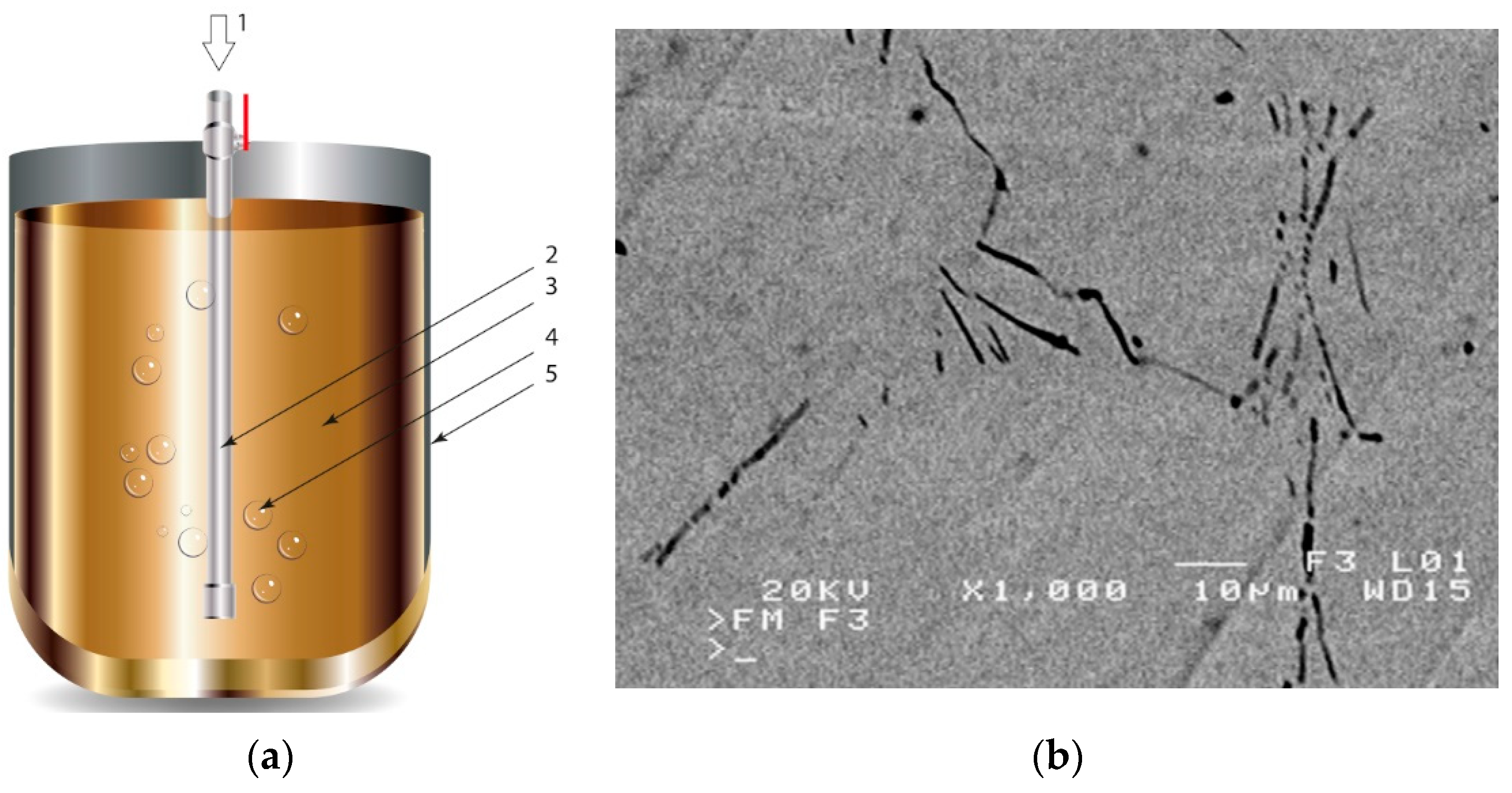
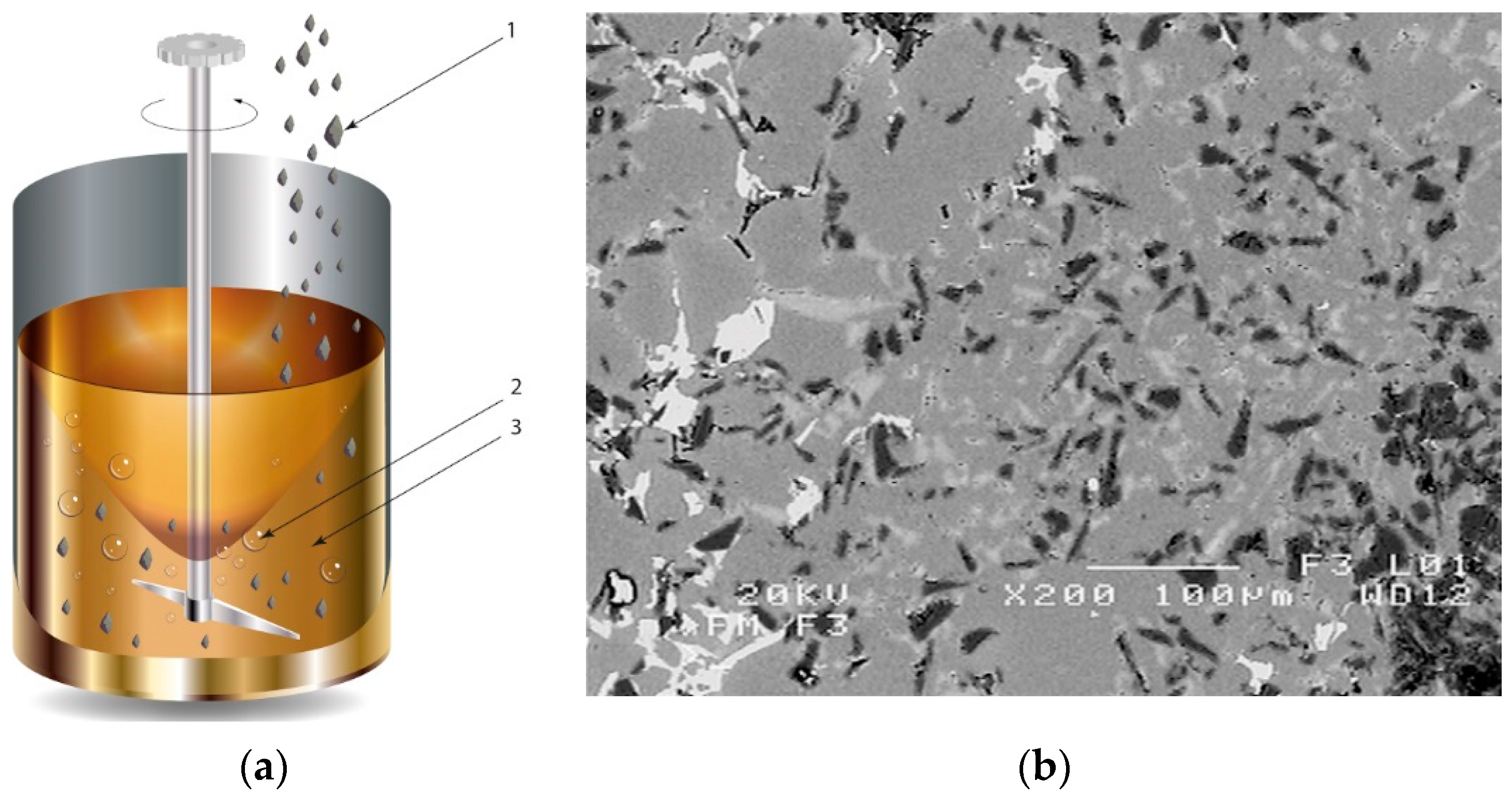
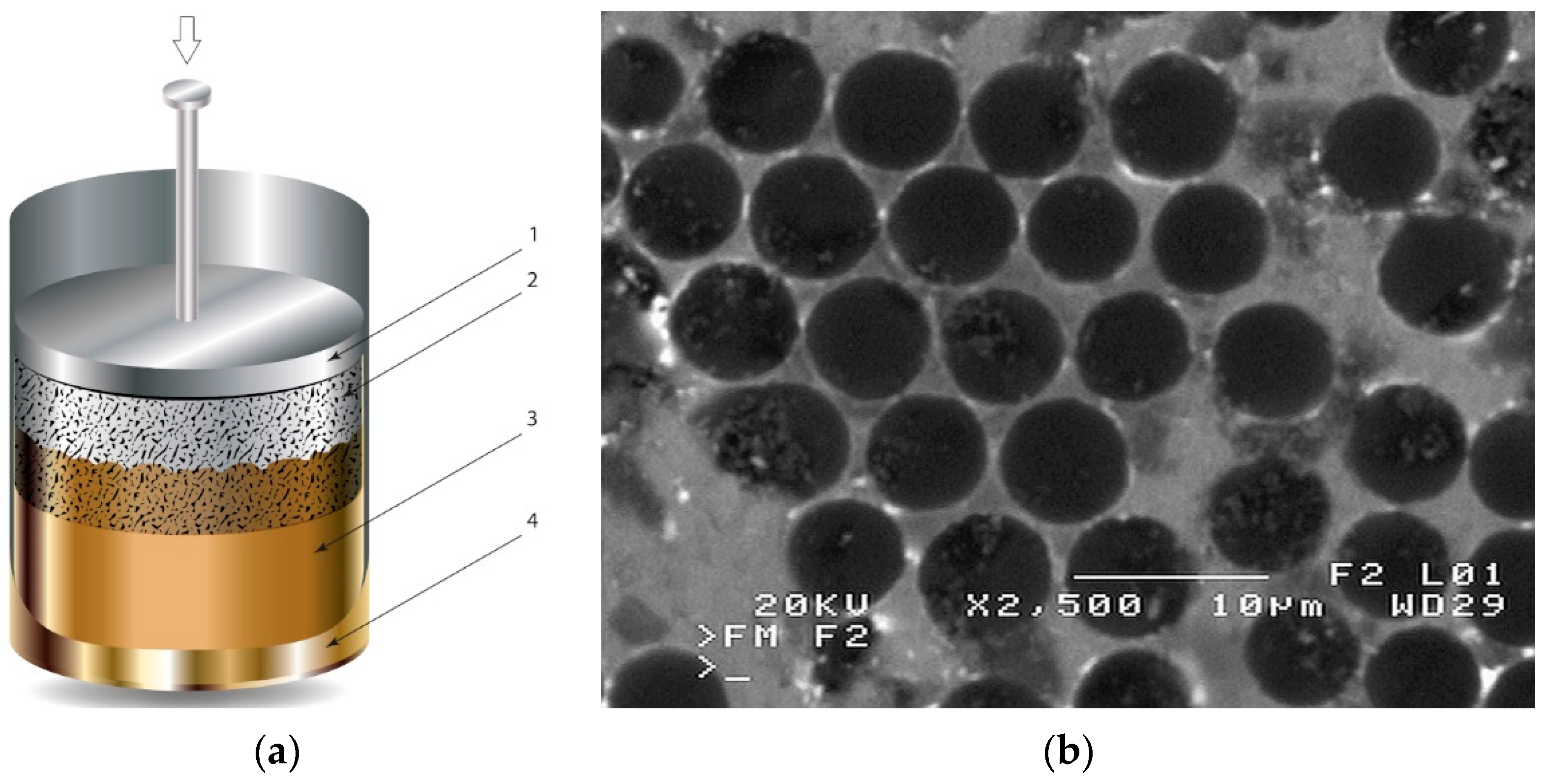



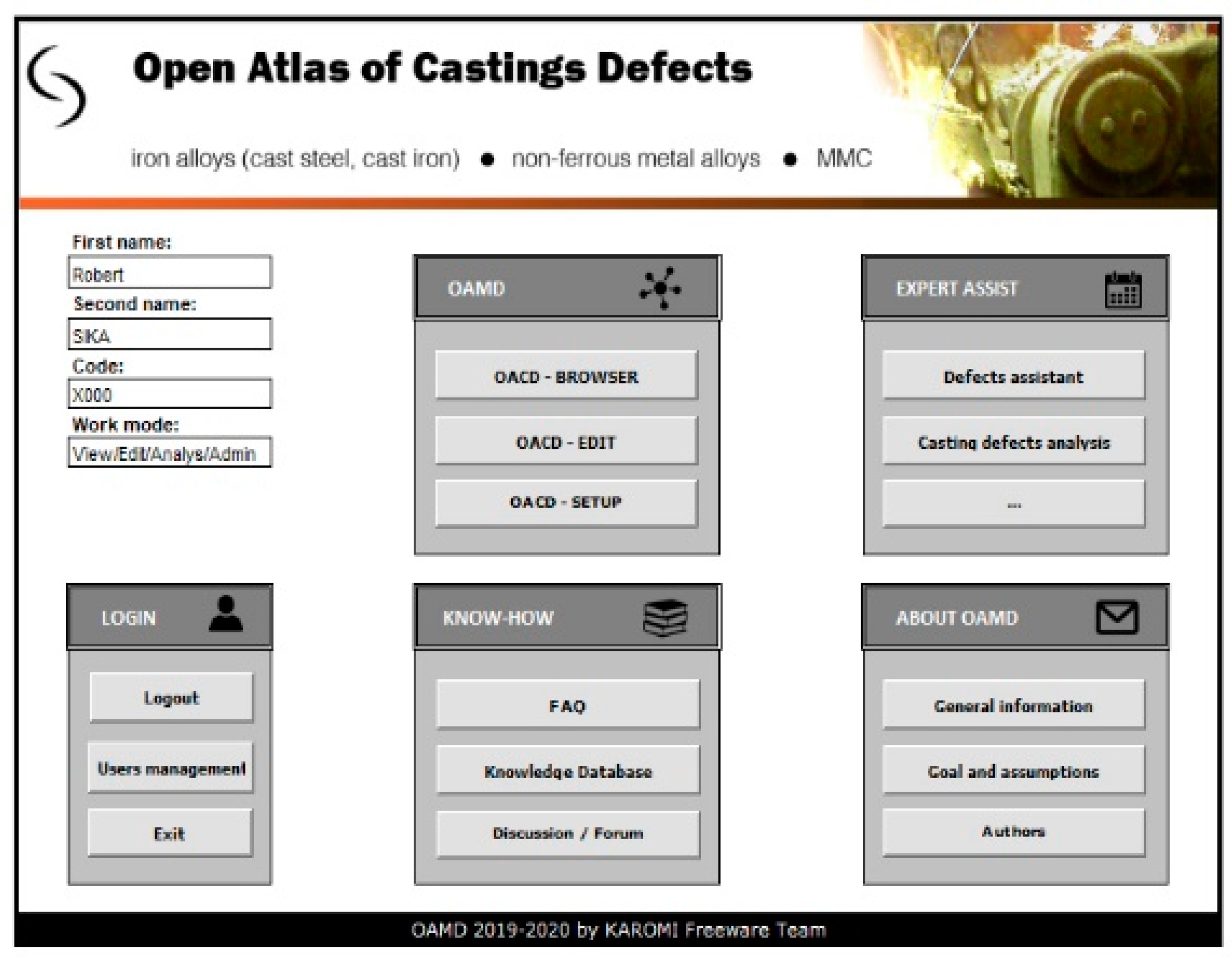
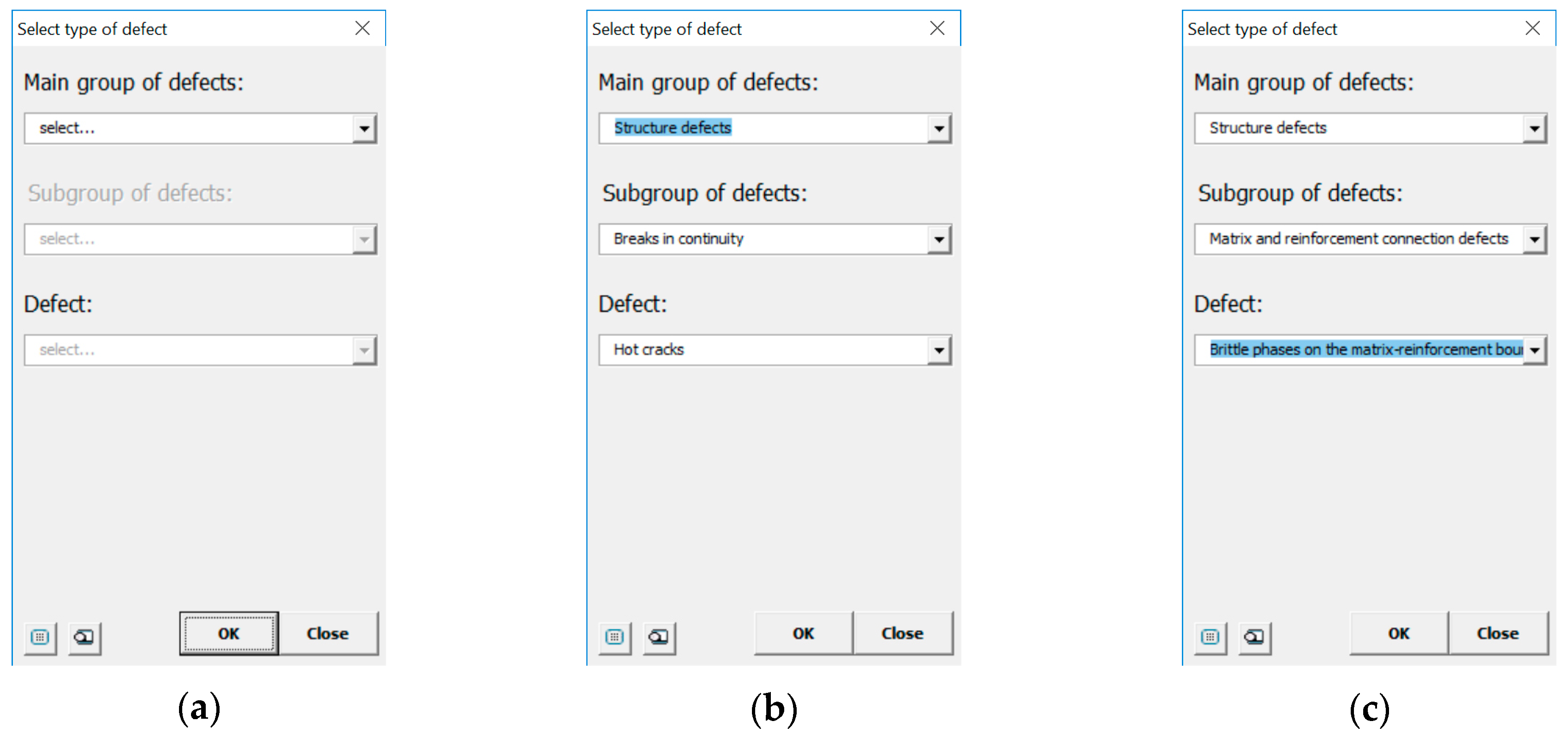
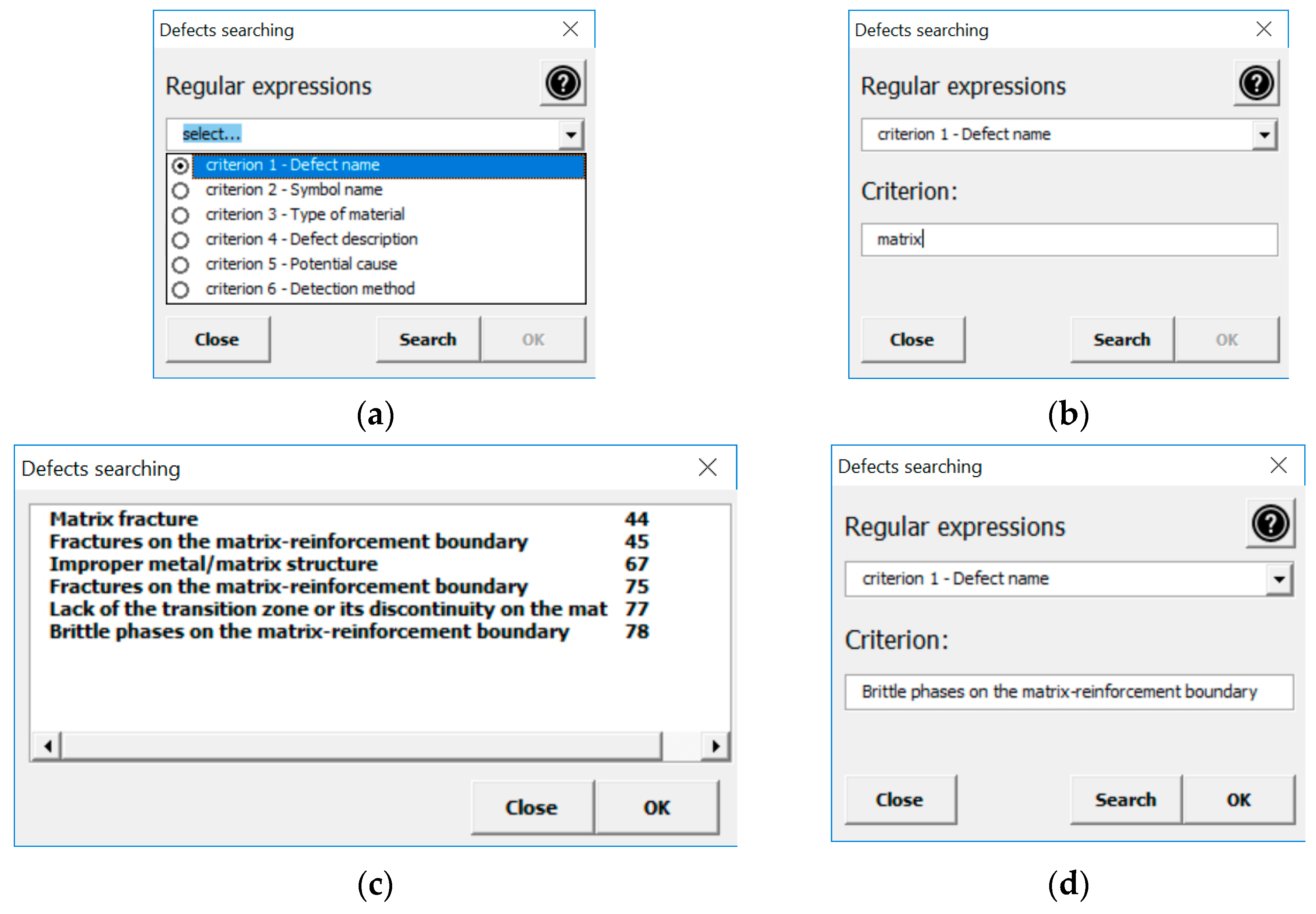

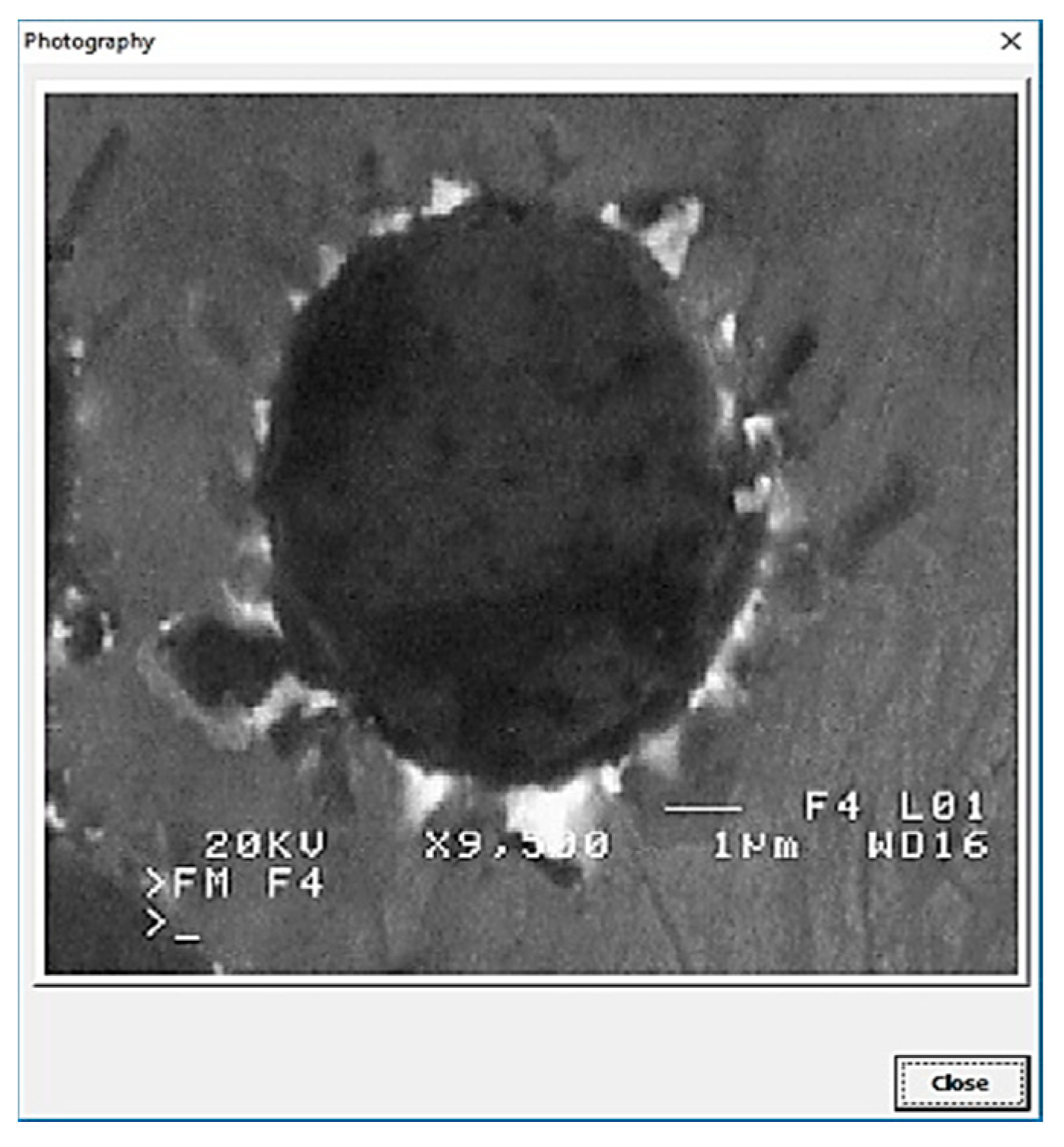
| Defect Name | Marking | Occurrence |
|---|---|---|
| Group 1—Shape Defects | ||
| Mechanical damage | W-101 | all alloys |
| Misrun | W-102 | all alloys |
| Knob | W-103 | all alloys |
| Flash | W-104 | all alloys |
| Mismatch (shift) | W-105 | all alloys |
| Swelling | W-106 | all alloys |
| Warping | W-107 | all alloys |
| Group 2—Raw Surface Defects | ||
| Roughness | W-201 | all alloys |
| External bubble | W-202 | all alloys |
| Pitted skin | W-203 | cast steel |
| Pock-marking | W-204 | all alloys |
| Pinholes | W-205 | all alloys |
| Shrinkage depression | W-206 | all alloys |
| Cold lap | W-207 | all alloys |
| Sand buckle | W-208 | all alloys |
| Rat tails | W-209 | all alloys |
| Sand holes | W-210 | all alloys |
| Crush | W-211 | all alloys |
| Contamination | W-212 | all alloys |
| Defect Name | Marking | Occurrence |
| Scale | W-213 | malleable cast iron |
| Galling | W-214 | non-ferrous metals |
| Partial melting (during annealing) | W-215 | malleable iron cast |
| Elephant skin | W-216 | spheroidal graphite iron |
| Sweat | W-217 | non-ferrous metals |
| Flowers | W-218 | non-ferrous metals |
| Metal penetration | W-219 | all alloys |
| Veins | W-220 | all alloys |
| Burning-on (of sand) | W-221 | all alloys |
| Sand holes | W-222 | all alloys |
| Oxidation | W-223 | non-ferrous metals |
| Peel | W-224 | malleable cast iron |
| Group 3—Discontinuities | ||
| Hot cracks | W-301 | all alloys |
| Cold cracks | W-302 | all alloys |
| Shrinkage cracks | W-303 | all alloys |
| Annealing cracks | W-304 | malleable cast iron |
| Transgranular cracks | W-305 | cast steel, non-ferrous metals |
| Group 4—Internal Defects | ||
| Gas bubble | W-401 | all alloys |
| Gas bubble | W-401 | all alloys |
| Porosity | W-402 | all alloys |
| Shrinkage cavity | W-403 | all alloys |
| Microporosity | W-404 | all alloys |
| Slag inclusion | W-405 | all alloys |
| Sand drops | W-406 | all alloys |
| Cold shots | W-407 | all alloys |
| Foreign metal | W-408 | all alloys |
| Segregation | W-409 | non-ferrous metals |
| Coarse-grained structure | W-410 | non-ferrous metals |
| Hard spots | W-411 | cast iron |
| Grey spots | W-412 | malleable cast iron |
| White fracture | W-413 | malleable cast iron |
| Bright fracture | W-414 | malleable cast iron |
| Bright border | W-415 | malleable cast iron |
| Heterogeneity | W-416 | all alloys |
| Symbol, Name, (Description) | Pictures and Scheme, Additional Description | Probable Causes | Detection or Identification Methods |
|---|---|---|---|
| SUBGROUP 3.1—Breaks in Continuity | |||
| Fractures of reinforcement elements (FRE) (break, crack, lack of continuity of reinforcement elements). | 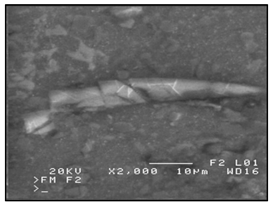 A1. SEM image of the clearly visible damages of the reinforcing phase in an ex situ composite, produced by saturating the reinforcement with liquid matrix (composite: silumin/Al2O3/SiO2).  A2. Scheme of fractures of reinforcement elements. | Improper manufacturing process too high, saturation pressure or the flow velocity of matrix metal. Internal stresses inside the casting, too intense mould cooling, too late removal of the casting from the mould, abrupt cooling of the casting after removing it from the mould. | Microscopic examinations (light-based, electron scanning). |
| [MF] Matrix fracture (MF) (breaks in matrix material continuity located most frequently around the reinforcing phase). |  B1. SEM image of the irregularly shaped breaks in the matrix structure in an ex-situ composite, produced by saturating the reinforcement with liquid matrix (composite: silumin/Al2O3/SiO2).  B2. Scheme of matrix fracture. | Internal stresses inside the casting caused by improper mould construction, improper mould temperature, too intense mould cooling, too late removal of the casting from the mould. | Microscopic examinations (light-based, electron scanning). |
| Fractures on the matrix-reinforcement boundary (FMRB) (no connection between the matrix and reinforcement). | 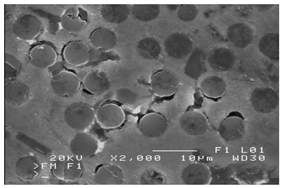 C1. SEM image of the visible breaks in continuity between the reinforcement and the matrix in an ex-situ composite, produced by saturation of the reinforcement with the matrix (composite: silumin/long carbon fibre). 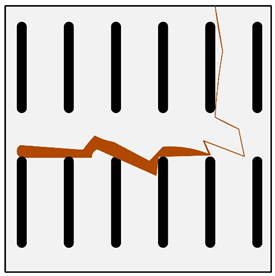 C2. Scheme of fractures on the matrix-reinforcement boundary. | Internal stresses inside the casting, improper mould temperature, too intense mould cooling, too late removal of the casting from the mould, abrupt cooling of the casting after removing it from the mould. | Microscopic examinations: (light-based, electron scanning). |
| SUBGROUP 3.2—Internal Defects | |||
| Inclusions (INC) (precipitations of chemical composition and structure different from the matrix or reinforcement). | 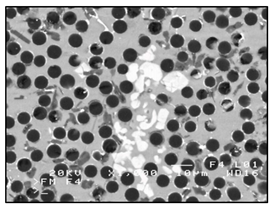 D1. SEM image of the inclusions in the composite structure, visible bright spots between the reinforcing phase—black circles, in an ex situ composite, produced by saturation of the reinforcement with the matrix (composite: silumin/long carbon fibre).  D2. Scheme of inclusions. | Impure charge material, improper chemical constitution. Improper process of melting and refining. Erosion of mould or its coating, caused by using wrong materials or too high flow velocity of matrix metal. | Microscopic examinations: (light-based, electron scanning). Ultrasound and radiography flaw detection. |
| Unfilled reinforcement spaces (URS) (free spaces in reinforcement and matrix contact zones). | 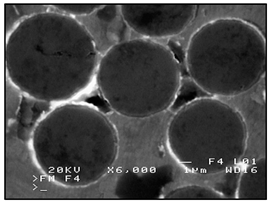 E1. SEM image of the unfilled reinforcement spaces due to, e.g., insufficient saturation in the ex-situ composite, produced by saturation of the reinforcement with the matrix (composite: silumin/long carbon fibre). 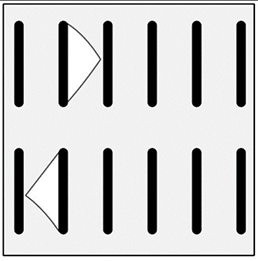 E2. Scheme of unfilled reinforcement spaces. | Improperly conducted manufacturing process, insufficient wetting of the reinforcement by the matrix. Too low saturation pressure, too low temperature of the reinforcement, matrix metal or mould. | Microscopic examinations (light-based, electron scanning). Gravimetric examination. |
| Occluded gas bubbles (OGB) (pores of a shape close to spherical, present in whole volume of the casting, with increased dimensions in isolated areas of the casting). | 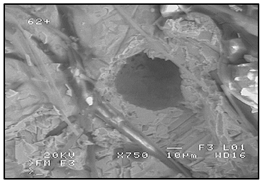 F1. SEM image of the occluded gas bubbles, in an ex situ composite, produced by saturating the reinforcement with the matrix (composite: silumin/short fibre Al2O3/SiO2).  F2. Scheme of occluded gas bubbles. | Improperly conducted manufacturing process, e.g., improper feed of matrix metal, too high velocity of saturation, too low temperature of reinforcement, matrix metal or mould, improper venting of the mould. | Microscopic examinations (light-based, electron scanning). Gravimetric examination Ultrasound and radiography flaw detection. Macroscopic examination. Computed tomography. Computer image analysis. |
| Separated (precipitated) Precipitate gas bubbles (SGB) (gas bubbles of a regular spherical shape, usually located on reinforcement elements). | 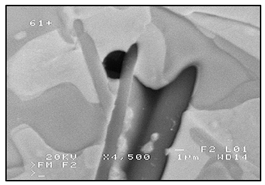 G1. SEM image of the precipitate gas bubbles located on the reinforcement fibre, in an ex situ composite, produced by saturation of the reinforcement with the matrix (composite: silumin/short fibre Al2O3/SiO2).  G2. Scheme of separated (precipitated). Precipitate gas bubbles. | Impure charge material, improperly prepared matrix material, improper melting or refining, improper preparation of reinforcement material. | Microscopic examinations (light-based, electron scanning). Gravimetric examination. Ultrasound and radiography flaw detection. Macroscopic examination. Computed tomography. Computer image analysis. |
| Improper metal/matrix structure (IMMS) (foreign phases, undesirable dendritic structure, presence of phases of variable chemical constitution, coarse grain structure). | 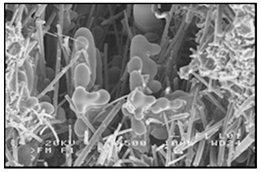 H1. SEM image of the incorrect matrix structure, dendrites of α phase in the structure of castings, formed on reinforcement fibres, produced by saturation of the reinforcement with the matrix (composite: silumin/short fibre Al2O3/SiO2).  H2. Scheme of improper metal/matrix structure. | Too high or too low temperature of the matrix metal, improper chemical constitution of the matrix metal, improper modification or lack thereof, improper mould temperature. | Microscopic examinations (light-based, electron scanning). Computer image analysis. X-ray microanalysis. |
| SUBGROUP 3.3—Reinforcement Defects | |||
| Inhomogeneity of size of reinforcement elements (ISiRE) (diversified size of the reinforcing phase). | 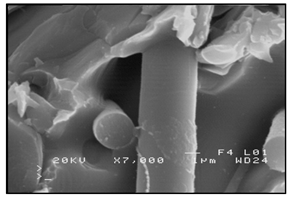 J1. SEM image of the inhomogeneity of size of reinforcement elements in the form of different sizes of reinforcement sections—black circles, in an ex-situ composite, produced by saturation of the reinforcement with the matrix(composite: silumin/short fibre Al2O3/SiO2).  J2. Scheme of inhomogeneity of size of reinforcement elements. | Bad quality of the reinforcement. | Microscopic examinations (light-based, electron scanning). Computed tomography. Computer image analysis. |
| [IDRE] Inhomogeneity of distribution of reinforcement elements (IDRE) (varied density of the reinforcing phase in different areas of the reinforcement). | 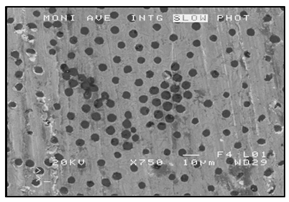 K1. SEM image of the clearly visible uneven distribution of reinforcing elements in the studied area, in an ex-situ composite, produced by saturation of the reinforcement with the matrix (composite: silumin/long carbon fibre).  K2. Scheme of inhomogeneity of distribution of reinforcement elements. | Bad quality of the reinforcement, overheating of the composite suspension, failure to mix the suspension, which may lead to sedimentation of the reinforcing phase particles, matrix contamination. | Microscopic examinations (light-based, electron scanning). Computed tomography Computer image analysis. |
| Foreign matter in the reinforcement structure (FMRS) (impurities formed during reinforcement manufacturing). |  L1. SEM image of the foreign matter in the reinforcement structure, identified fragment of another metal—iron in the composite structure. An ex situ composite, produced by saturation of the reinforcement with the matrix (composite: silumin/long carbon fibre). 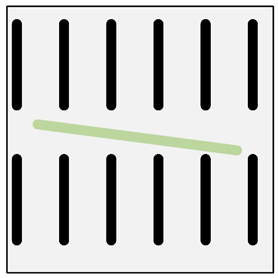 L2. Scheme of foreign matter in the reinforcement structure. | Bad quality of the reinforcement. Impure charge material. Improperly prepared matrix material, improper melting or refining, improper preparation of reinforcement material. | Microscopic examinations (light-based, electron scanning). X-ray microanalysis. |
| Deformation of the reinforcing structure (DTS) (improper shape of reinforcement structure. This defect occurs only in the group of an ex-situ saturated composites). | 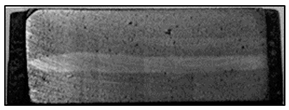 M1. Macroscopic image of the deformed bright area of the reinforcing moulder in an ex-situ composite, produced by saturating the reinforcement with the matrix (composite: silumin/short fibre Al2O3/SiO2). 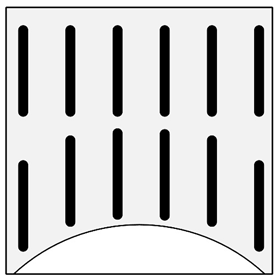 M2. Scheme of deformation of the reinforcing structure. | Mechanical damage to the reinforcement moulder. Too high pressure or velocity of matrix metal flow. | Macroscopic examination. Radiography flaw detection. Ultrasonic flaw detection. |
| Improper localization of the reinforcing structure (ILRS) (displacement of the reinforcement structure in the casting space. This defect occurs only in the group of an ex-situ saturated composites). |  N1. Macroscopic image of the unevenly distributed reinforcing moulder in an ex situ composite, produced by saturating the reinforcement with the matrix (composite: silumin/short fibre Al2O3/SiO2). 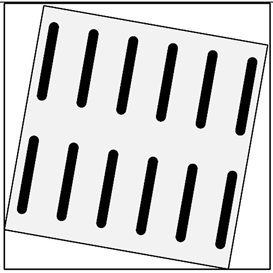 N2. Scheme of improper localization of the reinforcing structure. | Improper preparation of the mould, ensuring stable placement of the moulder, too high metal pressure which results in a shift in the reinforcement structure in the mould. | Macroscopic examination. Radiography flaw detection. Ultrasonic flaw detection. |
| SUBGROUP 3.4—Matrix and Reinforcement Connection Defects | |||
| Lack of the transition zone or its discontinuity on the matrix – reinforcement boundary (LTZ-DMRB) (visible lack of appearance of longitudinal band which is a transitional zone differing in colour and chemical composition from the structure of reinforcement and matrix). |  O1. Optical microscopy image of the transitional zone dark field on the boundary: matrix bright area, reinforcement grey-green area; an ex-situ composite produced by saturation of the reinforcement with the matrix (composite: silumin/steel fibre (Cr18Ni9)). 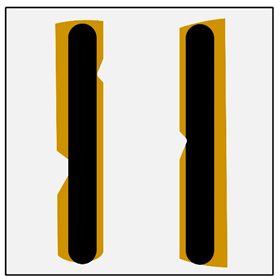 O2. Scheme of lack of the transition zone or its discontinuity on the matrix—reinforcement boundary. | Improper preparation of reinforcement, impurities of the reinforcement, e.g., failure to degrease. | Microscopic examinations (light-based, electron scanning). X-ray microanalysis. |
| Brittle phases on the matrix-reinforcement boundary (BP-MRB) (continuous or discontinuous brittle phases on the matrix-reinforcement boundary). |  P1. SEM image of the reinforcement in the form of bright points around the reinforcement (black circle) in an ex-situ composite, produced by saturation of the reinforcement with the matrix (composite: silumin/long carbon fibre).  P2. Scheme of brittle phases on the matrix-reinforcement boundary. | Mutual harmful interaction of the reinforcement and matrix metal (e.g., as a result of a chemical reaction). | Microscopic examinations (light-based, electron scanning). X-ray microanalysis. |
| Defect Name | Marking | Occurrence, Castings: |
|---|---|---|
| Group 1—Shape Defects | ||
| Mechanical damage | W-101 | all alloys, all metal composites |
| Misrun | W-102 | all alloys, all metal composites |
| Knob | W-103 | all alloys, all metal composites |
| Flash | W-104 | all alloys, all metal composites |
| Mismatch (shift) | W-105 | all alloys, all metal composites |
| Swelling | W-106 | all alloys, all metal composites |
| Warping | W-107 | all alloys, all metal composites |
| Group 2—Raw Surface Defects | ||
| Roughness | W-201 | all alloys, all metal composites |
| External bubble | W-202 | all alloys, all metal composites |
| Defect Name | Marking | Occurrence, Castings: |
| Pitted skin | W-203 | cast steel |
| Pock-marking | W-204 | all alloys, all metal composites |
| Pinholes | W-205 | all alloys, all metal composites |
| Shrinkage depression | W-206 | all alloys, all metal composites |
| Cold lap | W-207 | all alloys, all metal composites |
| Sand buckle | W-208 | all alloys, all metal composites |
| Rat tails | W-209 | all alloys, all metal composites |
| Sand holes | W-210 | all alloys, all metal composites |
| Crush | W-211 | all alloys, all metal composites |
| Contamination | W-212 | all alloys |
| Scale | W-213 | malleable cast iron |
| Galling | W-214 | non-ferrous metals |
| Partial melting (during annealing) | W-215 | malleable iron cast |
| Elephant skin | W-216 | spheroidal graphite iron |
| Sweat | W-217 | non-ferrous metals |
| Flowers | W-218 | non-ferrous metals |
| Metal penetration | W-219 | all alloys, all metal composites |
| Veins | W-220 | all alloys, all metal composites |
| Burning-on (of sand) | W-221 | all alloys, all metal composites |
| Sand holes | W-222 | all alloys |
| Oxidation | W-223 | non-ferrous metals |
| Peel | W-224 | malleable cast iron |
| Group 3—Discontinuities | ||
| Subgroup 1—Breaks in Continuity | ||
| Hot cracks | W-301 | all alloys, all metal composites |
| Cold cracks | W-302 | all alloys, all metal composites |
| Shrinkage cracks | W-303 | all alloys, all metal composites |
| Annealing cracks | W-304 | malleable cast iron |
| Transgranular cracks | W-305 | cast steel, non-ferrous metals |
| Fractures of reinforcement elements | Own marking W-300-31-1 | all metal composites |
| Matrix fracture | Own marking W-300-31-2 | all metal composites |
| Fractures on the matrix-reinforcement boundary | Own marking W-300-31-3 | all metal composites |
| Subgroup 2—Internal Defects | ||
| Inclusions | Own marking W-400-32-1 | all metal composites |
| Unfilled reinforcement spaces | Own marking W-400-32-2 | all metal composites |
| Occluded bubbles | Own marking W-400-32-3 | all metal composites |
| Separated gas bubbles | Own marking W-400-32-4 | all metal composites |
| Gas bubble | W-401 | all alloys, all metal composites |
| Defect Name | Marking | Occurrence, Castings: |
| Porosity | W-402 | all alloys, all metal composites |
| Shrinkage cavity | W-403 | all alloys, all metal composites |
| Microporosity | W-404 | all alloys, all metal composites |
| Slag inclusion | W-405 | all alloys, all metal composites |
| Sand drops | W-406 | all alloys, all metal composites |
| Cold shots | W-407 | all alloys, all metal composites |
| Foreign metal | W-408 | all alloys, all metal composites |
| Segregation | W-409 | non-ferrous metals |
| Coarse-grained structure | W-410 | non-ferrous metals |
| Hard spots | W-411 | cast iron |
| Grey spots | W-412 | malleable cast iron |
| White fracture | W-413 | malleable cast iron |
| Bright fracture | W-414 | malleable cast iron |
| Bright border | W-415 | malleable cast iron |
| Heterogeneity | W-416 | all alloys, all metal composites |
| Improper metal/matrix structure | Own marking W-400-32-5 | all alloys, all metal composites |
| Subgroup 3—Reinforcement Defects | ||
| Inhomogeneity of shape of reinforcement elements | Own marking W-500-33-1 | all metal composites |
| Inhomogeneity of size of reinforcement elements | Own marking W-500-33-2 | all metal composites |
| Inhomogeneity of distribution of reinforcement elements | Own marking W-500-33-3 | all metal composites |
| Foreign matter in the reinforcement structure | Own marking W-500-33-4 | all metal composites |
| Deformation of the reinforcing structure | Own marking W-500-33-5 | saturated metal composites |
| Improper localization of the reinforcing structure | Own marking W-500-33-6 | saturated metal composites |
| Fractures on the matrix-reinforcement boundary | Own marking W-500-33-7 | all metal composites |
| Subgroup 4—Matrix and Reinforcement Connection Defects | ||
| Lack of the transition zone or its discontinuity on the matrix – reinforcement boundary | Own marking W-600-34-1 | all metal composites |
| Brittle phases on the matrix-reinforcement boundary | Own marking W-600-34-2 | all metal composites |
© 2020 by the authors. Licensee MDPI, Basel, Switzerland. This article is an open access article distributed under the terms and conditions of the Creative Commons Attribution (CC BY) license (http://creativecommons.org/licenses/by/4.0/).
Share and Cite
Sika, R.; Rogalewicz, M.; Popielarski, P.; Czarnecka-Komorowska, D.; Przestacki, D.; Gawdzińska, K.; Szymański, P. Decision Support System in the Field of Defects Assessment in the Metal Matrix Composites Castings. Materials 2020, 13, 3552. https://doi.org/10.3390/ma13163552
Sika R, Rogalewicz M, Popielarski P, Czarnecka-Komorowska D, Przestacki D, Gawdzińska K, Szymański P. Decision Support System in the Field of Defects Assessment in the Metal Matrix Composites Castings. Materials. 2020; 13(16):3552. https://doi.org/10.3390/ma13163552
Chicago/Turabian StyleSika, Robert, Michał Rogalewicz, Paweł Popielarski, Dorota Czarnecka-Komorowska, Damian Przestacki, Katarzyna Gawdzińska, and Paweł Szymański. 2020. "Decision Support System in the Field of Defects Assessment in the Metal Matrix Composites Castings" Materials 13, no. 16: 3552. https://doi.org/10.3390/ma13163552
APA StyleSika, R., Rogalewicz, M., Popielarski, P., Czarnecka-Komorowska, D., Przestacki, D., Gawdzińska, K., & Szymański, P. (2020). Decision Support System in the Field of Defects Assessment in the Metal Matrix Composites Castings. Materials, 13(16), 3552. https://doi.org/10.3390/ma13163552








